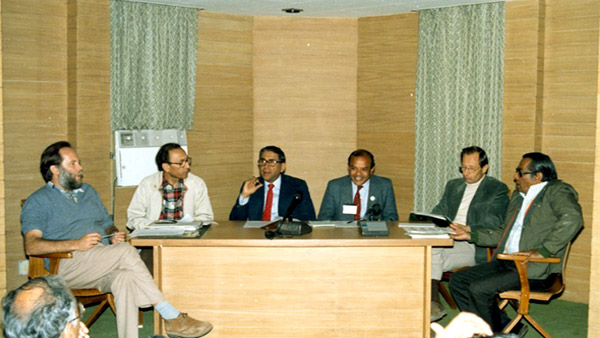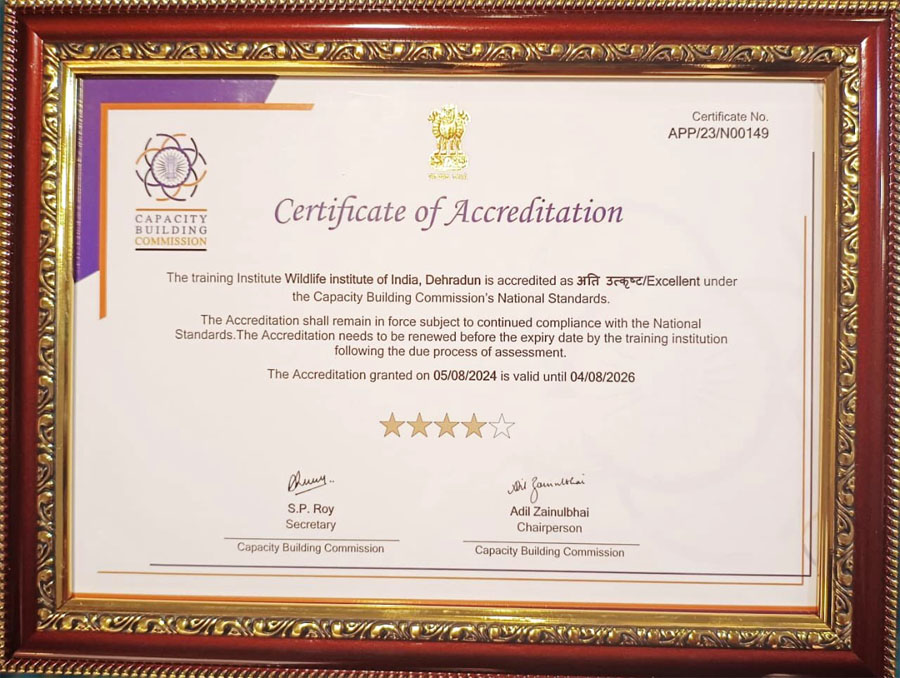The Wildlife Institute of India is a nodal national agency for research and training in the field of wildlife conservation. The institute is a four-star top rated accredited institute as per the Capacity Building Commission amongst all National Civil Service Training Institute. Its mandate includes generating quality knowledge in wildlife science and complement national efforts in wildlife conservation. Over the years it has served the urgent capacity building needs for scientific planning, management and research in the field of wildlife conservation both in country and the region

Mission of WII
To nurture the development of wildlife science & promote its application in conservation in consonance with our cultural and socio-economic milieu.
Aims & Objectives
- Build up scientific knowledge on wildlife resources.
- Train personnel at various levels for conservation and management of wildlife.
- Carry out research relevant to management including the development of techniques appropriate to Indian conditions.
- Provide information and advice on specific wildlife management problems.
- Collaborate with international organizations on wildlife research, management and training.
- Develop as a regional centre of international importance on wildlife and natural resource conservation.

Established in 1982, Wildlife Institute of India (WII) is an internationally acclaimed Institution, which offers training program, academic courses and advisory in wildlife research and management. The Institute is actively engaged in research across the breadth of the country on biodiversity related issues.
The Institute's idyllic campus that has been carefully developed to create state of the art infrastructure encourages scholarly work. WII's research projects being conducted in field sites across the length and breadth of the country are the primary sources of scientific information to help conservation. They are also the means of keeping the institute's faculty abreast of current field situations and the latest technology.
Background
In the last half century, India's once rich biodiversity has become considerably depleted. Rapid human and livestock population increase and a rather lopsided development pattern have marginalized or unjustly exploited the country's bountiful wilderness areas such that the species richness and the range of habitat types that the country used to be proud of are today highly eroded and fragmented. How can this fall be checked and reversed is now a question being pondered over.
This sense of introspection is an encouraging sign indeed. There are some other encouraging signs as well. For instance, the forest departments, the custodians of forests in the country, no longer see their custody as purely industrial raw material but a vital cog in the ecological wheel for the ultimate and sustained well being of humanity. Such a realization will, in the long run, help overcome the shortcomings and failures of early protective measures to preserve wilderness areas, which still remains one of the most effective ways of conserving the country's biodiversity.
Amidst such a situation, the need was felt for an organization to help and strengthen endeavors for recovery. It was important to have an agency which, while looking at forests holistically, combined their management with conserving their biodiversity and protecting the interests of the people in their vicinity in a manner that would be practical and scientifically oriented. Such a thought process led to the setting up of Wildlife Institute of India (WII) at Dehradun in 1982 with a mandate to train government and non-government personnel, carry out research, and advise on matters of conservation and management of wildlife resources.
For WII, it was a challenging task, particularly when education in forest management had nothing on wildlife, and wildlife science itself had not yet been established as a subject of any significance in the university education curriculum. With no precedence to go by, WII had to virtually single handedly not only give forest education a wildlife slant but also create and develop the very resources with which it could go about fulfilling its tasks.
This apparent disadvantage ultimately became the institute's strength because the freshness of approach gave it a strong foundation and prevented its programmes from becoming mere academic exercises. WII's programmes are field based and seek an integration of biological, socio-economic and human aspects of large regional landscapes. As a result, wildlife conservation today means not just providing protection mainly to a few splendid species but that it be holistic and have considerations for humans living in the vicinity as well.
WII's research projects being conducted in field sites across the length and breadth of the country are the primary sources of scientific information to help conservation. They are also the means of keeping the institute's faculty abreast of current field situations and the latest technology.
 In its endeavours, WII has had the benefit of international and bilateral collaborations for institutional building, faculty development, infusion of modern technology and creation of a scientific infrastructure. These collaborations are worked out with wildlife organizations, scientific institutions and universities at the national as well as international levels.
In its endeavours, WII has had the benefit of international and bilateral collaborations for institutional building, faculty development, infusion of modern technology and creation of a scientific infrastructure. These collaborations are worked out with wildlife organizations, scientific institutions and universities at the national as well as international levels.
WII was accorded autonomy in April 1986, which furthered its pace of growth. With many countries in south and south-east Asia region regularly sending their personnel to its training programmes, WII is already considered an important regional centre for training and education in wildlife management and conservation.
Citizen Charter
Introduction
The Wildlife Institute of India (WII) was established at Dehradun in 1982. In 1986, it was granted the status of an autonomous Institution of the Ministry of Environment & Forests, Govt. of India, New Delhi. WII is now recognized as a premier regional institution for training and research in biodiversity conservation. A large number of foresters and wildlife managers from other developing countries, particularly south and south-east Asia, have been trained in WII since its establishment. WII has given a new direction to the concept and practice of biodiversity conservation, made it more practical and realistic by seeking the involvement and cooperation of local people. However, the problem and challenges are immense and diverse in a constantly changing scenario. Learning from its own and others experiences, WII traverses a path of hope which will help strengthen its inputs and find answers to conservation issues and problems in the developing world.
Vision
To develop the Institute as 'A Global Centre of Excellence' in the field of wildlife research, training and advocacy.
Mission
To nurture the development of wildlife science and promote its application in conservation, in consonance with our culture and socio-economic milieu.
Objectives
- Building knowledge base in wildlife science
- Building capacity of forest personnel and other key stakeholders of various levels for conservation and management of wildlife
- Conduct Research Projects on various aspects of wildlife and its efficient management.
For more information on Citizen Charter of Wildlife Institute of India (WII)
